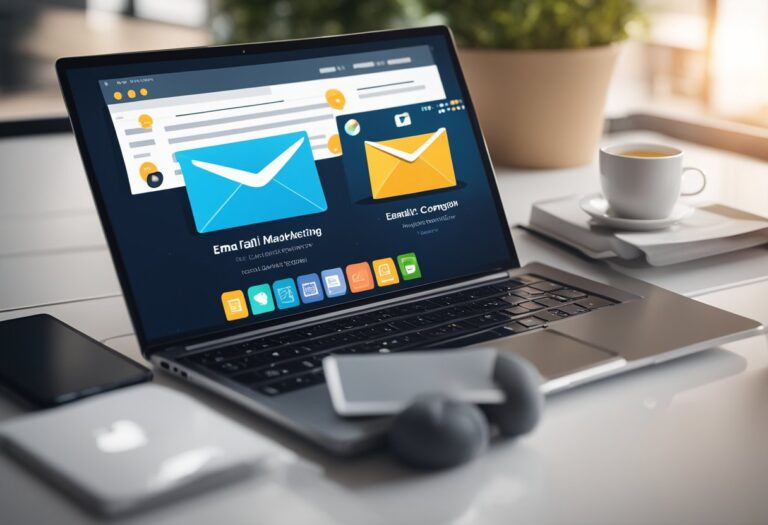Email Marketing: 6 Steps to Build a Profitable Email List
Building a profitable email list is the foundation of successful Email Marketing. Without a strong list, your campaigns won’t reach the right audience, and your conversion rates will suffer. However, simply collecting email addresses isn’t enough—you need a strategic approach to attract engaged subscribers who are genuinely interested in your brand. That is to say, growing an email list requires more than just a sign-up form; it demands careful planning, valuable content, and smart optimization.
In this guide, we’ll walk you through six proven steps to Create an email list that drives real results. From crafting irresistible lead magnets to optimizing your opt-in forms, each step is designed to help you build and maintain a high-quality subscriber base. Moreover, with the right strategies in place, you can turn casual visitors into loyal customers who are eager to hear from you. So, if you’re ready to take your Email Marketing to the next level, let’s dive in!
Table of Contents
Create an Irresistible Lead Magnet
Building a profitable email list starts with a powerful lead magnet. A lead magnet is a free resource or incentive that encourages visitors to share their email addresses in exchange for something valuable. In other words, it’s a strategic way to Attract high-quality subscribers who are genuinely interested in your content, products, or services. Instead of asking people to sign up without a reason, offering a compelling lead magnet makes them feel like they are getting exclusive benefits, which increases conversions.
Types of Lead Magnets
There are various types of lead magnets, and choosing the right one depends on your audience’s needs and preferences. Here are some highly effective options:
| Lead Magnet Type | Description | Best Use Case |
|---|---|---|
| E-books & Guides | In-depth educational content | Great for industries like marketing, fitness, and finance |
| Discounts & Coupons | Special offers for subscribers | Ideal for e-commerce businesses |
| Free Courses & Webinars | Educational video lessons | Best for coaching, training, and online courses |
| Templates & Checklists | Ready-to-use resources | Perfect for productivity, design, and marketing professionals |
| Exclusive Content | Members-only articles, reports, or case studies | Works well for news, business, and finance blogs |
| Quizzes & Assessments | Interactive tools with personalized results | Great for engagement-based marketing |
Best Practices for High Conversions
To maximize sign-ups, your lead magnet must be relevant, high-quality, and offer instant value. Here are some key best practices:
- Solve a Specific Problem – Your lead magnet should directly address a pain point your audience faces.
- Make It Easy to Access – Avoid complex sign-up processes. The simpler, the better.
- Ensure High Quality – A well-designed and well-written resource builds trust with your audience.
- Use Strong CTAs – Clearly explain the benefits and encourage users to take action.
- Test & Optimize – A/B test different lead magnets to see what converts best.
💡 Note: Your lead magnet should be directly related to your email marketing strategy. If your goal is to promote a product, create a lead magnet that naturally leads to a purchase decision.
By implementing these strategies, you’ll not only Grow your email list but also attract highly engaged subscribers who are more likely to convert into loyal customers. 🚀
Optimize Your Opt-In Forms for Maximum Sign-Ups
Even the best email marketing strategy won’t work if your opt-in forms aren’t optimized for conversions. Your opt-in form is the gateway to growing your email list, so it needs to be strategically placed, easy to fill out, and compelling enough to encourage sign-ups. That is to say, a well-placed and well-crafted opt-in form can significantly boost your subscriber growth rate. Let’s explore the best ways to optimize your forms.
Strategic Form Placement
Placing opt-in forms in the right locations ensures maximum visibility and engagement. Here are the most effective placements:
| Placement | Best For | Why It Works |
|---|---|---|
| Homepage | General audience | Ensures high visibility for new visitors |
| Blog Posts | Engaged readers | Captures leads when interest is high |
| Sidebar or Floating Bar | Site-wide engagement | Keeps the form accessible at all times |
| Pop-ups | Lead capture | Commands attention but should be used wisely |
| Exit-Intent Forms | Visitors about to leave | Gives users a last chance to subscribe |
💡 Note: Using multiple opt-in forms across different sections of your website increases the chances of capturing leads. However, avoid overloading visitors with excessive pop-ups, as this may negatively impact user experience.
Single vs. Double Opt-in
Choosing between single opt-in and double opt-in can affect your email list quality and engagement. Here’s a quick comparison:
| Opt-in Type | Pros | Cons |
|---|---|---|
| Single Opt-in | Faster sign-ups, higher conversion rates | More fake/spam emails, lower engagement |
| Double Opt-in | Higher-quality subscribers, better engagement | Fewer sign-ups, extra verification step |
If you prioritize quality over quantity, double opt-in ensures that subscribers genuinely want to be on your list. However, if rapid growth is your goal, a single opt-in may be a better choice.
Crafting a Compelling CTA
Your call-to-action (CTA) is the final push that convinces users to subscribe. Instead of a generic “Sign Up” button, use action-driven and benefit-focused CTAs that highlight what subscribers will gain.
✅ Examples of High-Converting CTAs:
- “Get My Free E-book Now!” – Creates urgency and highlights the benefit.
- “Unlock Exclusive Discounts!” – Appeals to e-commerce customers.
- “Join 10,000+ Smart Marketers!” – Uses social proof for credibility.
- “Send Me Weekly Growth Hacks!” – Reinforces value and personalization.
💡 Note: A/B testing different CTA variations can help determine what resonates best with your audience.
Segment and Personalize Your Email List
One of the most effective ways to improve email marketing performance is through list segmentation and personalization. Instead of sending the same email to everyone, you can divide your audience into smaller groups based on their interests, behaviors, or demographics. That is to say, segmentation allows you to send highly relevant content, resulting in higher engagement, better open rates, and increased conversions.
Why Segmentation Matters
When subscribers receive emails that resonate with their needs, they are more likely to open, click, and take action. Here’s how segmentation boosts email marketing results:
| Benefit | Impact on Email Marketing |
|---|---|
| Higher Open Rates | Personalized subject lines attract more clicks. |
| Increased Engagement | Relevant content keeps subscribers interested. |
| Lower Unsubscribe Rates | Fewer people leave when emails match their interests. |
| Better Conversion Rates | Targeted offers lead to more sales and sign-ups. |
| Improved Deliverability | Engaged subscribers reduce spam complaints. |
💡 Note: Studies show that segmented campaigns can increase email revenue by up to 760% compared to non-segmented ones!
Ways to Segment Your List
There are several ways to categorize subscribers for more personalized emails. Here are the most effective segmentation strategies:
| Segmentation Type | Example Data | Best Use Case |
|---|---|---|
| Demographics | Age, gender, location | Sending region-specific promotions |
| Behavioral | Website visits, email opens | Retargeting engaged users with relevant content |
| Purchase History | Past orders, cart abandonment | Recommending related products or special offers |
| Engagement Level | Active vs. inactive subscribers | Sending re-engagement campaigns |
💡 Note: Combining multiple segmentation criteria can help fine-tune your targeting and improve email marketing ROI.
Using Email Automation Tools
Managing segmentation manually can be time-consuming. Thankfully, Email automation tools help streamline the process by automatically sorting subscribers based on their actions and preferences. Here are some of the best tools:
| Email Tool | Key Features for Segmentation |
|---|---|
| HubSpot | Advanced segmentation, CRM integration |
| Mailchimp | Pre-built audience segments, automation workflows |
| ConvertKit | Tag-based segmentation, ideal for creators |
| ActiveCampaign | AI-powered automation, behavioral tracking |
💡 Note: These tools allow you to create dynamic email segments, meaning subscribers are automatically moved between groups based on their activity.
Engage and Nurture Subscribers with Valuable Content
Getting people to sign up for your email list is just the beginning. To turn subscribers into loyal customers, you need to engage and nurture them with high-value content. Consistently delivering relevant, informative, and Engaging emails helps strengthen relationships, boost open rates, and increase conversions. That is to say, the more valuable your emails, the more likely subscribers will trust your brand and take action.
The Power of Welcome Emails
The welcome email is one of the most important emails you’ll ever send. It’s your first opportunity to make a strong impression and set the tone for future communication. Here’s why it matters:
| Benefit | Why It’s Important |
|---|---|
| Higher Open Rates | Welcome emails have an average open rate of 50%+. |
| Builds Trust | Introduces your brand and sets clear expectations. |
| Encourages Engagement | Guides subscribers on what to do next. |
| Reduces Unsubscribes | Helps subscribers understand the value of staying on your list. |
💡 Note: A great welcome email should be warm, personalized, and action-driven—for example, encouraging new subscribers to check out your best content or claim a freebie.
Content That Converts
Not all emails are created equal. To keep subscribers engaged, you need to provide content that adds value and solves their problems. Here are some high-converting content types:
| Email Type | Purpose | Best Use Case |
|---|---|---|
| Newsletters | Keeps subscribers updated | Ideal for weekly or monthly updates |
| Educational Content | Provides tips, tutorials, or insights | Great for nurturing and engagement |
| Exclusive Offers | Rewards loyal subscribers | Best for boosting sales and conversions |
| Surveys & Feedback Requests | Engages and learns from subscribers | Helps improve email strategy |
💡 Note: A mix of content keeps emails fresh and prevents subscribers from tuning out.
Avoiding Spam Triggers
Even the best content won’t work if your emails end up in the spam folder. To maintain a healthy sender reputation, follow these best practices:
- Avoid Spammy Words – Words like “FREE!!!,” “Act Now,” and “Limited Time” can trigger spam filters.
- Use a Recognizable Sender Name – Subscribers are more likely to open emails from a familiar sender.
- Include an Easy Unsubscribe Option – This improves trust and reduces spam complaints.
- Monitor Your Email Engagement – Low open rates can affect email deliverability, so clean your list regularly.
💡 Note: Email marketing success depends on consistent engagement. If subscribers don’t open your emails for months, your future emails may be flagged as spam.
Track, Analyze, and Optimize for Growth
To maximize the success of your email marketing strategy, you need to continuously track performance, analyze data, and optimize your campaigns. That is to say, monitoring key metrics helps you understand what’s working and what needs improvement. By leveraging data-driven insights, you can fine-tune your emails for better engagement, higher conversions, and long-term growth.
Key Metrics to Monitor
Tracking the right email marketing metrics ensures that you stay on top of your campaign’s performance. Here are the most important metrics to monitor:
| Metric | What It Measures | Why It’s Important |
|---|---|---|
| Open Rate | Percentage of recipients who opened your email | Indicates subject line effectiveness |
| Click-Through Rate (CTR) | Percentage of recipients who clicked a link | Measures engagement and content relevance |
| Conversion Rate | Percentage of subscribers who took the desired action | Determines campaign success |
| Bounce Rate | Percentage of emails that weren’t delivered | Helps maintain email list health |
| Unsubscribe Rate | Identifies if the content is relevant to your audience | Identifies if content is relevant to your audience |
💡 Note: A sudden drop in open rates or CTR may indicate that your subject lines or email content needs improvement.
A/B Testing Strategies
A/B testing (or split testing) allows you to compare two versions of an email to see which performs better. By making small adjustments and testing different elements, you can optimize your emails for higher engagement.
| Element to Test | What to Experiment With | Impact on Performance |
|---|---|---|
| Subject Lines | Length, wording, emojis, urgency | Affects open rates |
| Email Copy | Tone, length, personalization | Impacts engagement |
| CTA (Call-to-Action) | Button color, wording, placement | Influences conversions |
| Send Time | Day of the week, time of day | Affects open and click rates |
💡 Note: Test only one element at a time to accurately measure what influences performance.
Improving Deliverability
Even the best emails won’t help if they don’t reach your subscribers’ inboxes. To maintain high email deliverability, follow these best practices:
- Stay GDPR & CAN-SPAM Compliant – Ensure you have permission to email subscribers.
- Clean Your Email List Regularly – Remove inactive subscribers to improve engagement rates.
- Authenticate Your Emails – Use SPF, DKIM, and DMARC to prevent emails from being flagged as spam.
- Encourage Engagement – Ask subscribers to reply, whitelist, or mark emails as important to boost inbox placement.
💡 Note: If too many people mark your emails as spam, your sender’s reputation will suffer, leading to poor deliverability
Conclusion
Building a profitable email list doesn’t happen overnight, but by following these six essential steps, you’ll be well on your way to creating a highly engaged and valuable subscriber base. To recap:
- Create an Irresistible Lead Magnet – Offer value upfront with something that attracts your ideal subscribers.
- Optimize Your Opt-In Forms – Place forms strategically and use compelling CTAs to encourage sign-ups.
- Segment and Personalize Your Email List – Target subscribers based on their preferences and behaviors for higher engagement.
- Engage and Nurture Subscribers with Valuable Content – Deliver content that adds value, builds trust, and nurtures relationships.
- Track, Analyze, and Optimize for Growth – Monitor key metrics, test your campaigns, and continuously improve your strategies.
- Improve Deliverability – Ensure your emails land in the inbox by maintaining a clean list and following best practices for compliance.







